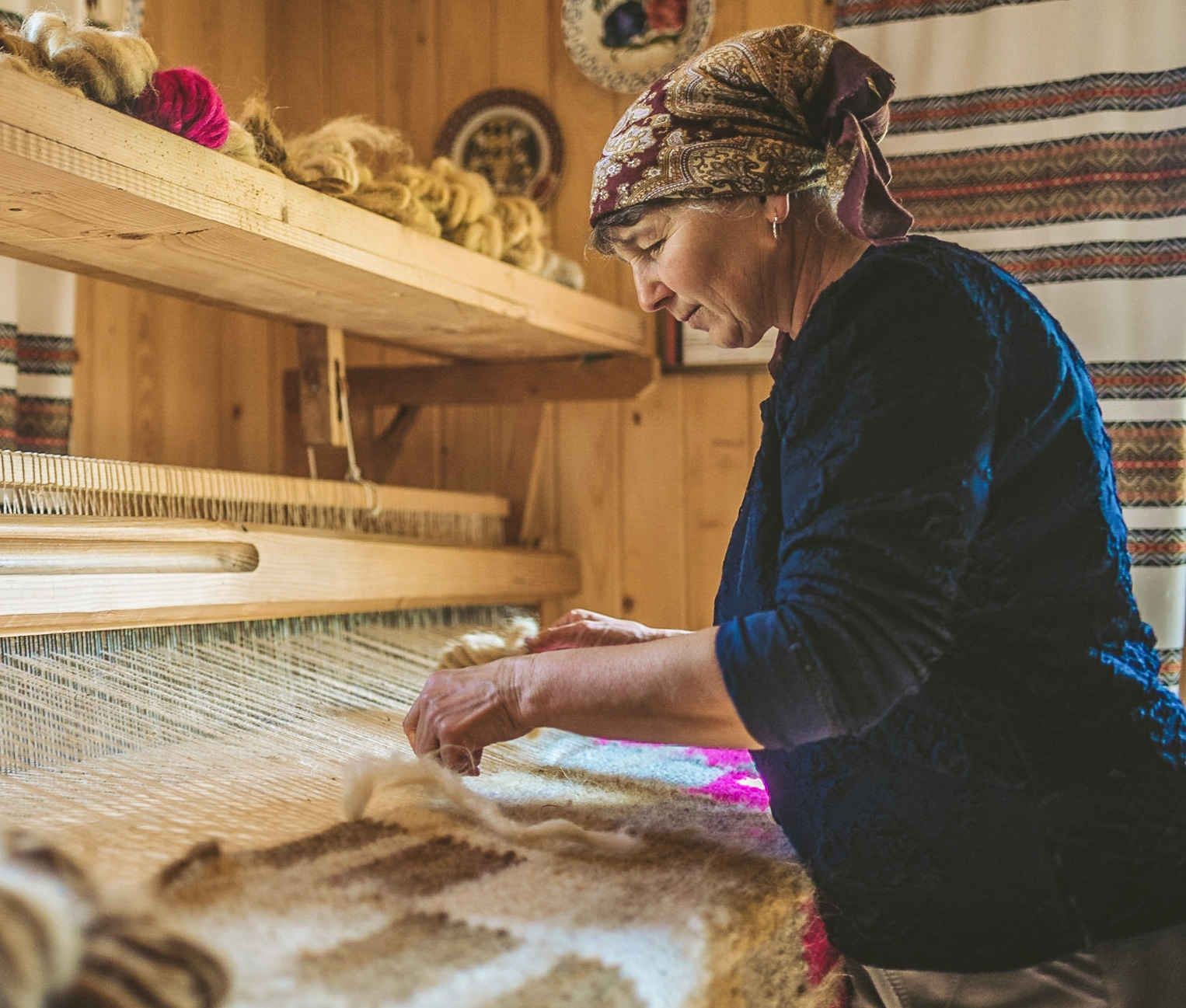Yavoriv, a settlement in Hutsulshchyna region, has always been famous for the beautiful works of its artisans; decorated Easter eggs (pysankas), embroidery and woodwork are widespread here. However, there’s something else makes Yavoriv such a special place: the art of making lizhnyks — woolen blankets, normally with a pattern and fluffy texture on one or both sides, also known as “hutsulian blankets”. Lizhnyks are very common in everyday life, used to soften beds or benches, and for extra warmth in the wintertime. They’re warm and attractive, but most importantly, their natural material, pure wool, is good for your health, massaging the skin and encouraging good blood flow — although it can be itchy at times.
None of the locals can tell you for sure when the first lizhnyks were made, but they will tell you that they’ve been making them for as long as they can remember. As it turns out, the tradition’s origin is closely related to sheep breeding. This specific area used to provide perfect conditions for raising sheep, who are the source of wool used to make lizhnyks.
Today, the wool is delivered from Zakarpattia, but the production itself continues in Yavoriv. Now, you can virtually find blankets of any kind: different sizes, colours, and pattern complexity.
But the first products were very different from the ones made nowadays. They were mostly monochromatic; grey, white, black or striped. In order to create a large one, they had to sew together a few smaller lizhnyks because the looms, which were used for production, were half the width of modern ones, which are typically at least one meter wide and can serve for forty to fifty years.

Changes in the manufacturing of lizhnyks started in the 1920s, when a teacher from a small village married a local girl. Together, they developed a manufacturing project which is still used today. They improved the loom and weaving technique, which made it possible to produce colored blankets, with green, red and cherry-red being the most popular colors at the time. With this, the mass production of woolen blankets was launched and the art of making lizhnyks was introduced to the rest of the world. In the 1930s, the blankets were displayed at international expositions, including in the USA and Poland.
Back in the USSR, they used to make woolen blankets with complicated patterns in factories. Women would submit original patters and images annually, and the best four or five would be selected and distributed craftswomen.
But now we’ve come full-circle: simple patterns such as the diametrical three-colored are back in fashion. These lizhnyks are easier and faster to produce, the cost is lower and they seem to be more popular among customers.
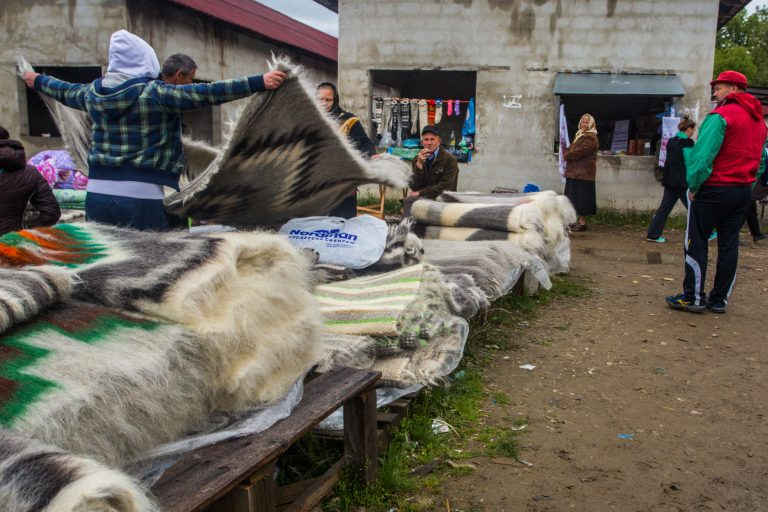
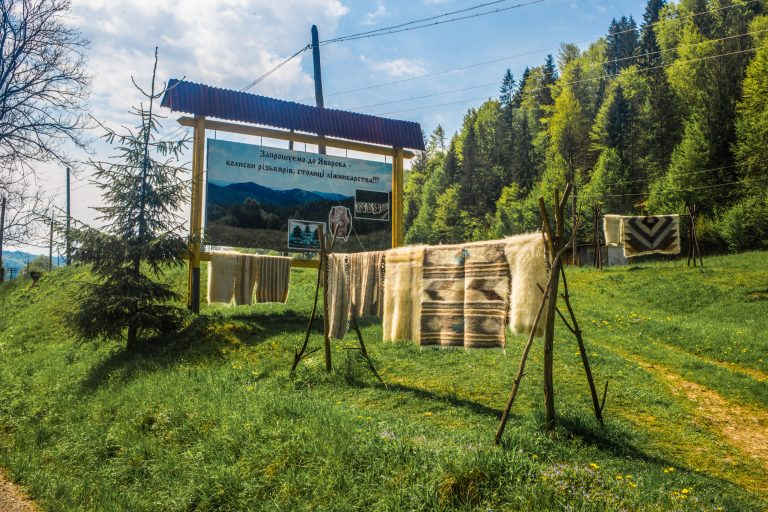
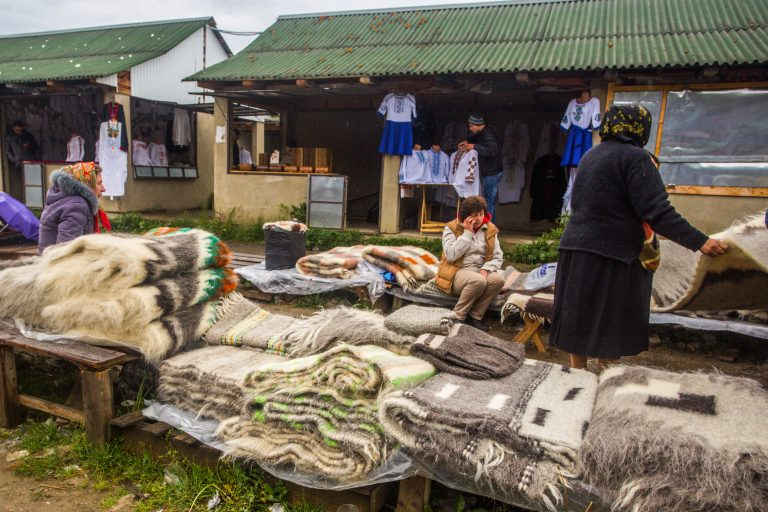
slideshow
Woolen blankets are not lacking popularity, but the number of artisans who know the art is decreasing rapidly. This downward slope is caused by a few factors. First of all, young people are shying away from physically-challenging work which doesn’t provide a high income. And since the weavers are mostly elderly women, there are fewer people to replace them every year. Secondly, the great flood of 2008 destroyed a significant number of water tumbles valylo along the riverside, which is important in the production of lizhnyks. The slow manufacturing process created long waiting times and forced many artisans to quit. There are about sixty craftswomen left in Yavoriv, who still produce woolen blankets. They sell them over the internet or at the market once a week.
Valylo
A large wooden tub, narrowed downwards, into which a stream of water flows with a huge force, which creates a whirlpool where woolen blankets are “tumbled”.One such craftswoman, Hanna Kopylchuk, says it is vital to preserve the tradition.
— As long as tradition and skills live, we shall endure. If they vanish, life will have no purpose for us. Tablets and smartphones have no tradition; they are not a tradition as they appeared just recently. If something goes off in space, they become pointless. Our tradition will survive — you make yourself a spindle and you’re good.
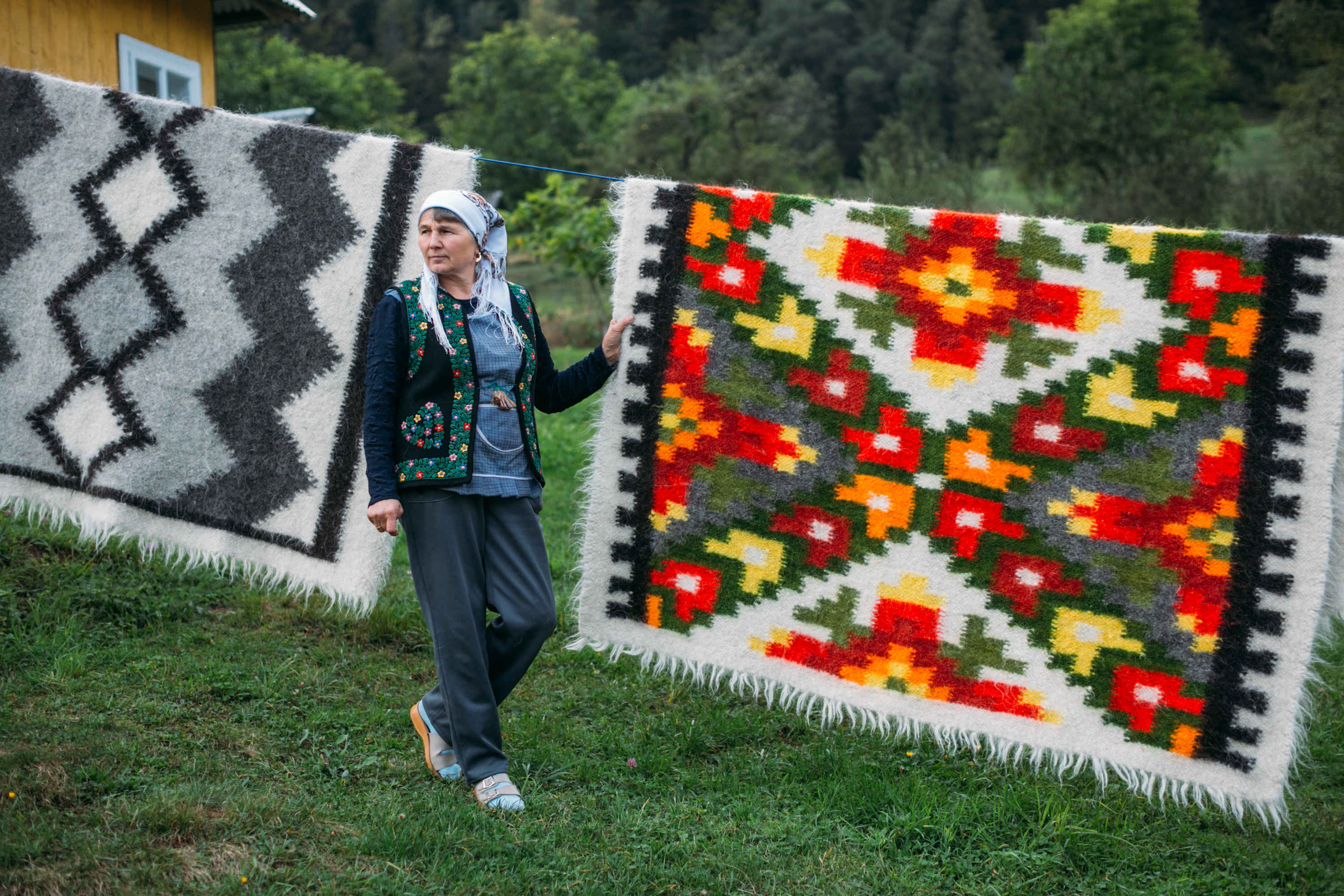
Family business
Many residents of Yavoriv have looms for blanket manufacturing at home, and locals are introduced to the art in their early childhood. Kids would get charged with minor tasks from time to time, and responsibilities would become greater as they grew older. Descendants of the artisans quickly realized that there was no way to avoid this tradition.
Hanna grew up in a similar environment, her mother used to train her to make lizhnyks.
— My grandparents used to make woolen blankets, — she says. — So did my mother, cause she had to, and so do I. I’ve been doing it for forty years.
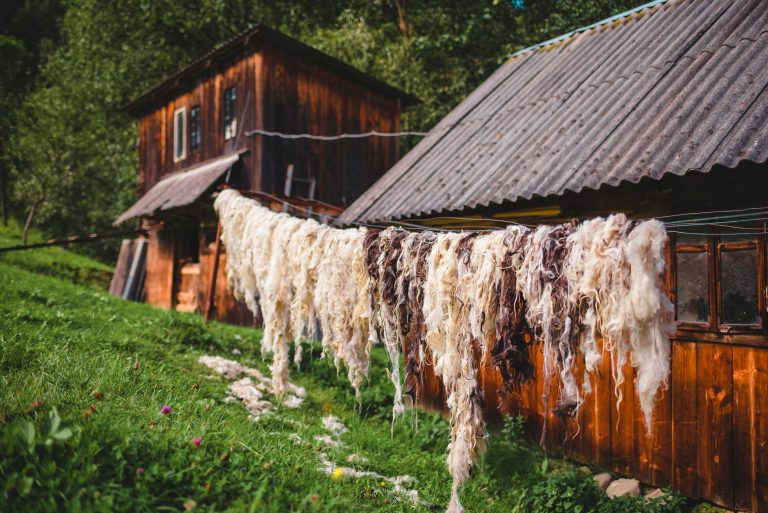
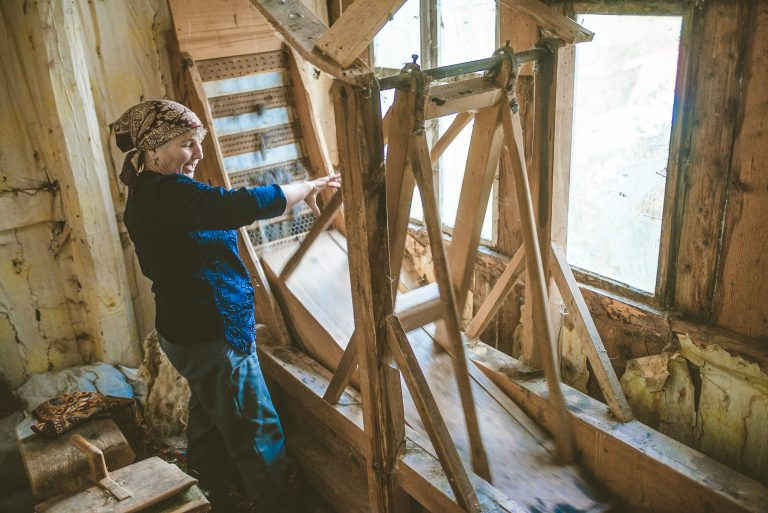
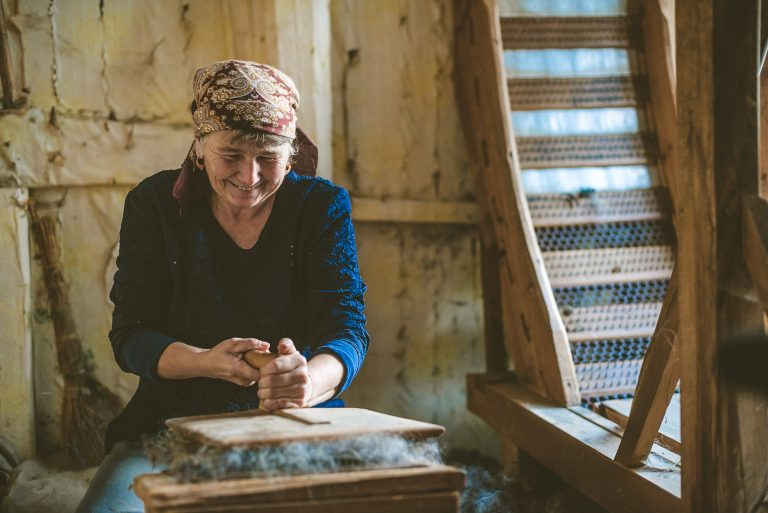
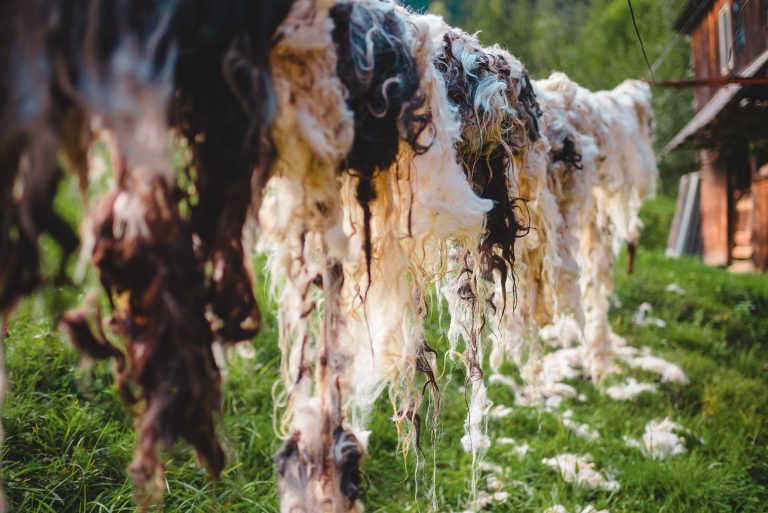
slideshow
Lizhnyk manufacturing technology hasn’t changed since her grandma’s times. The only improvement was that they now hatchel (to comb — ed.) the wool before spinning the thread.
Making lizhnyks is a family business, not only because this craft is passed through generations, but also because there is work for everyone. Hanna, for example, is assisted by her husband. He does the heavy work: washes the wool, hackles the blankets when they are ready, helps with the spinning of the thread, and operates the water tumble. Hanna’s kids are also familiar with manufacturing process, although it’s not their primary occupation, and they help with weaving when they feel like doing it.
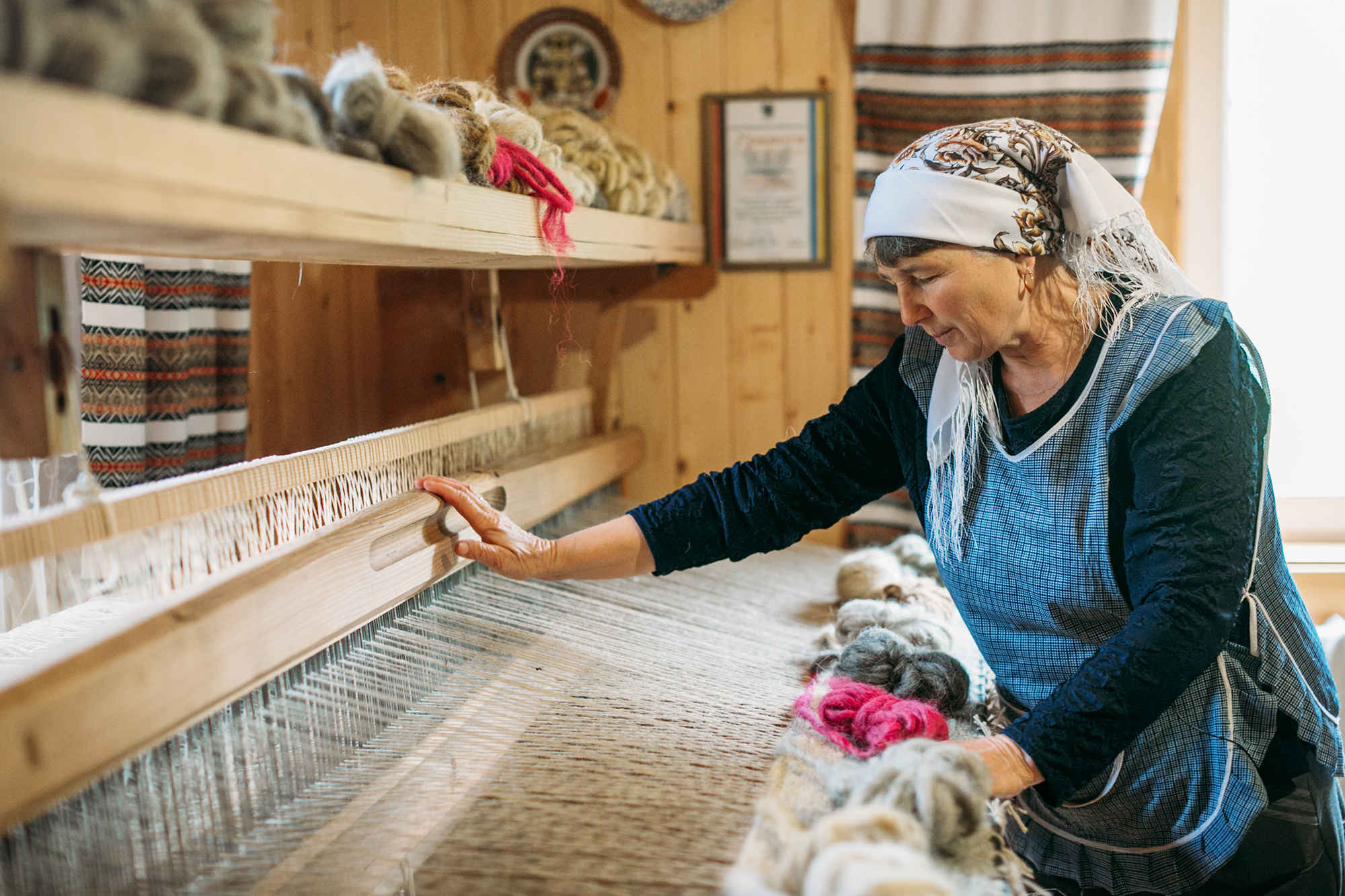
Hanna Kopylchuk
Hanna Kopylchuk is a member of the National Union of Folk Masters. She has been producing woolen blankets since her childhood. At the age of five she was already helping her mother with weaving. She made her first lizhnyk when she was a student in grade nine or ten, and by the age of eighteen, she could go through the entire production process on her own.
She wasn’t very impressed with this art at first, but eventually found herself falling in love with it. In her heart, she realized that weaving is a creative type of work because there was so much room for alterations and constant improvement. Besides, there were profits from her hobby. She started as an employee at a local factory, but now she creates pre-ordered blankets. She even refused a job offer at a local restaurant as a traditional Hutsul-dish cook — that is how much she loves making lizhnyks. It has become an important part of her life.
— The thing we like about our art is its uniqueness — you won’t find the same anywhere else in the world. We are simple folk, but we create something that’s one-of-a-kind.
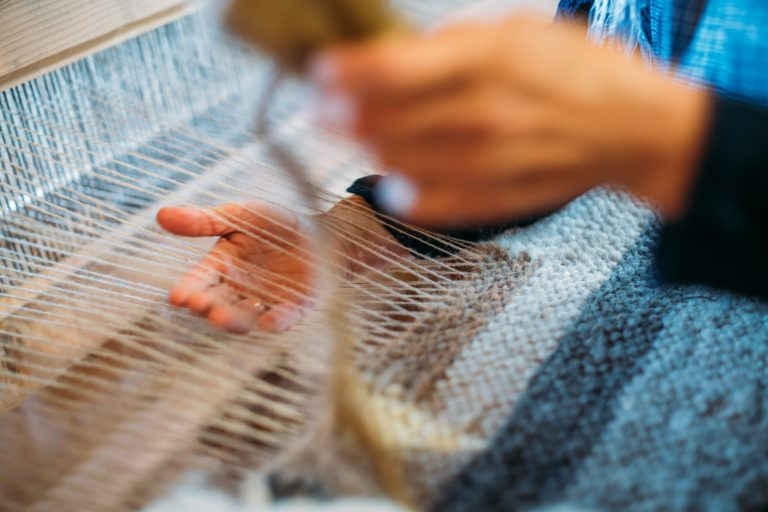
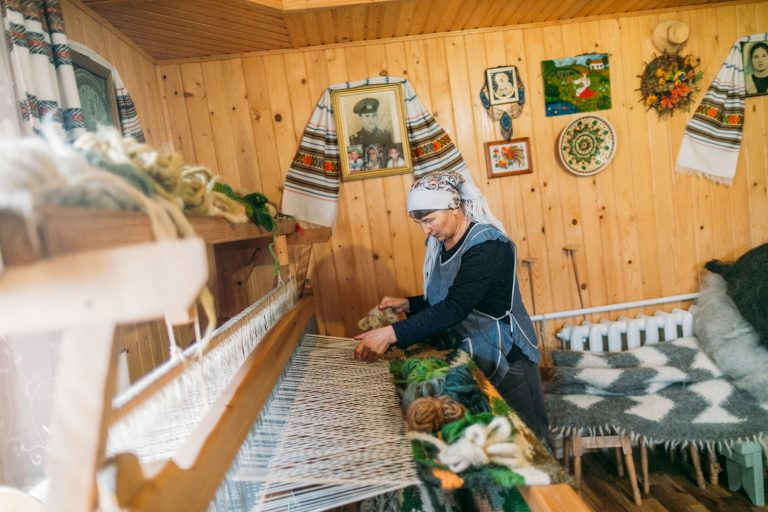
slideshow
Hanna is said to be the most skilled artisan, though she can’t explain why. She says she makes a good warp: she spins a thin thread, spends a lot of time weaving. She applies creativity to her work, chooses different colors and adds something special every time. The craftswoman even has a collection of images, weaved only by her. Recently, Hanna had a personal exhibition in Ivano-Frankivsk, where her modern and renewed works were displayed. Hanna Kopylchuck also presented her craft overseas: in Poland, in Lithuania and other Baltic countries.
Natalia Kischuk
Like other artisans, Natalia has been weaving since her childhood. It attracted her like a magnet:
— I didn’t have any intention of learning to weave. It was more like child’s play, fun. We now live by the road, closer to civilization, but in my youth, I lived on a hill. There was more communication with nature and we paid more attention to family business. When grandma got distracted by something, or went to cook lunch, I would step up to the loom and weave the best I could. So, involuntarily, I mastered this craft. Absorbed it, so to say. It’s like an addiction — I can’t be without it. I’m happy to have this hobby. I’m always told to move to Kyiv or Poland to work, but I don’t want to. I am glad I do this — it lets me stay where I am and be useful to others.
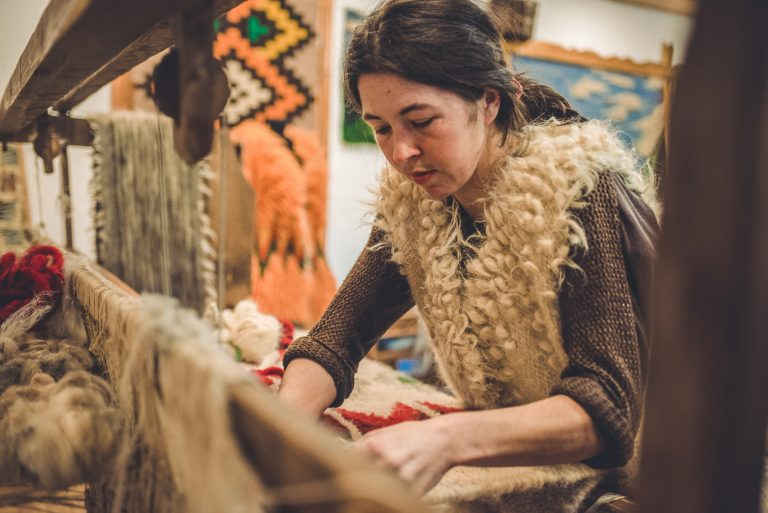
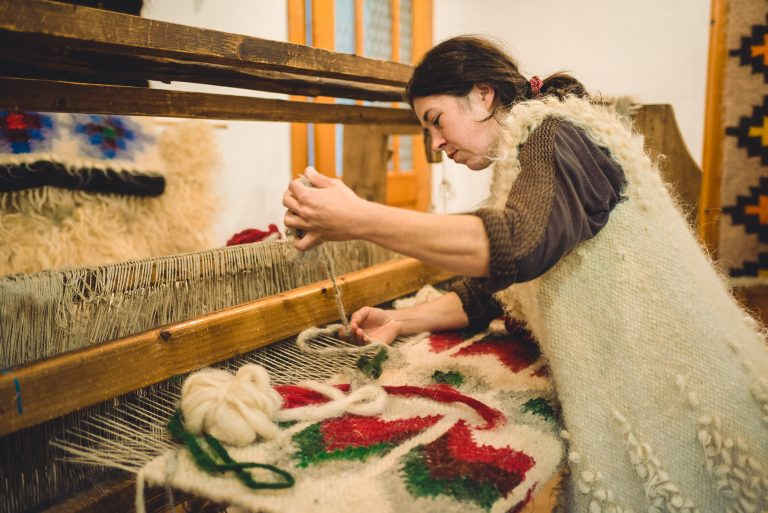
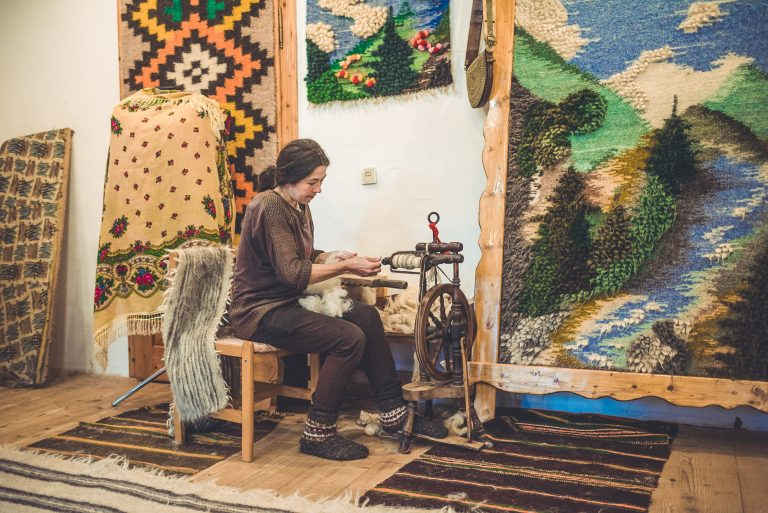
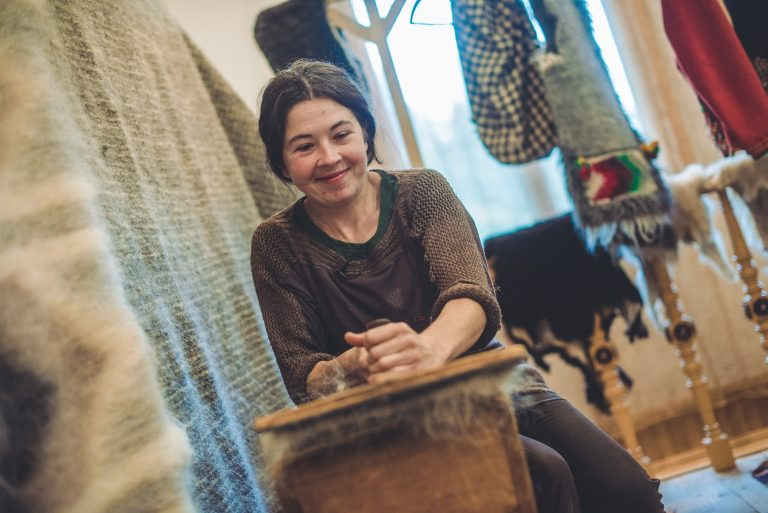
slideshow
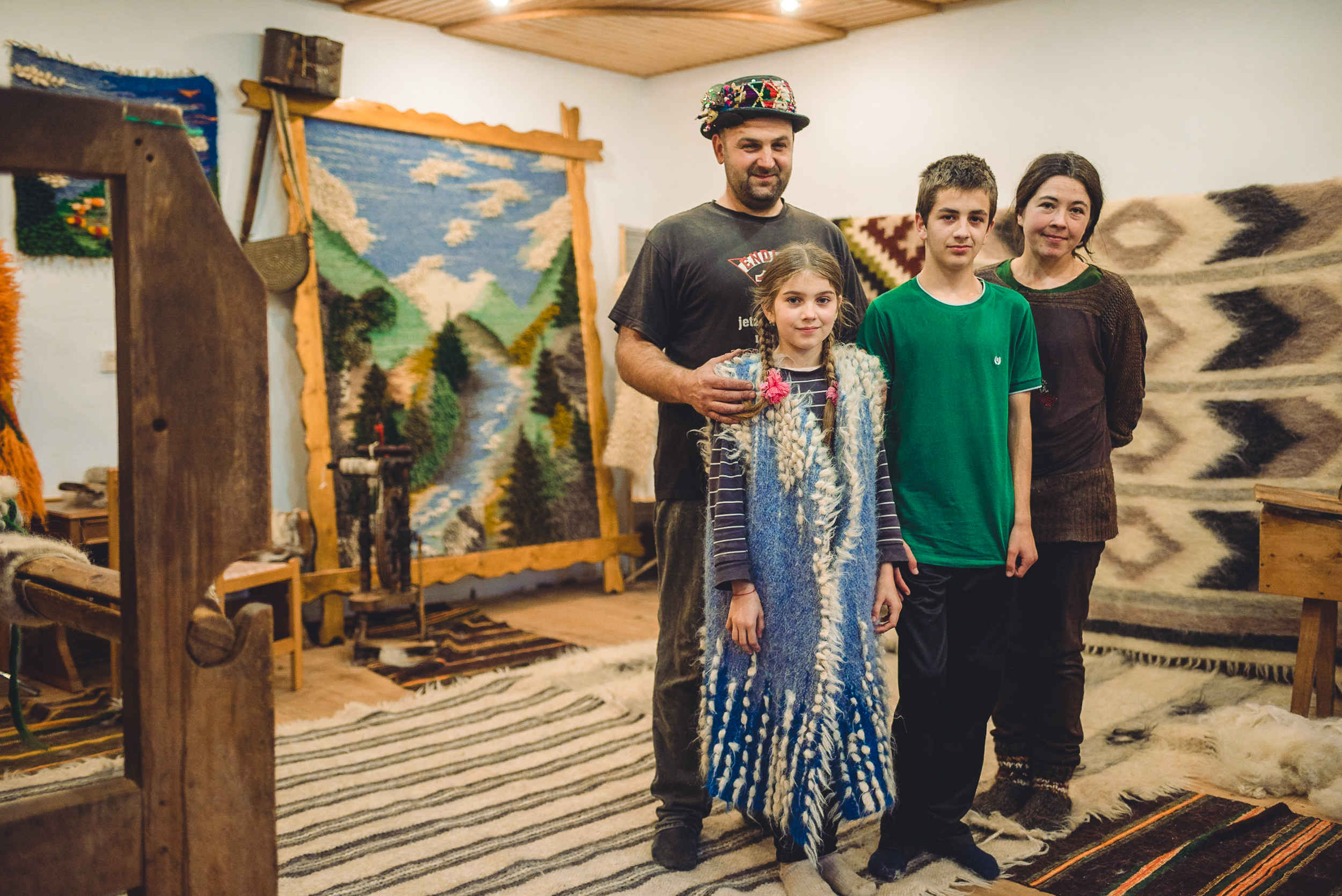
Natalia often consults her husband or her mother about colors and patterns because she wants everything to be perfect. The walls of her creative studio are decorated with incredible mountain landscapes that she weaved herself. It is a place to get better acquainted with Hutsul culture. They produce gunna, woolen hats, and sleeveless jackets. Here, you can see a loom, the antique spinning wheel that Natalia’s grandma used back in the day.
— People now show interest, — says Natalia. — We are glad about that, because we make it not only for money, but also to show it to the world. Life is more interesting this way and there is a chance this art will keep on developing.
Gunna
Traditional Hutsul cloaks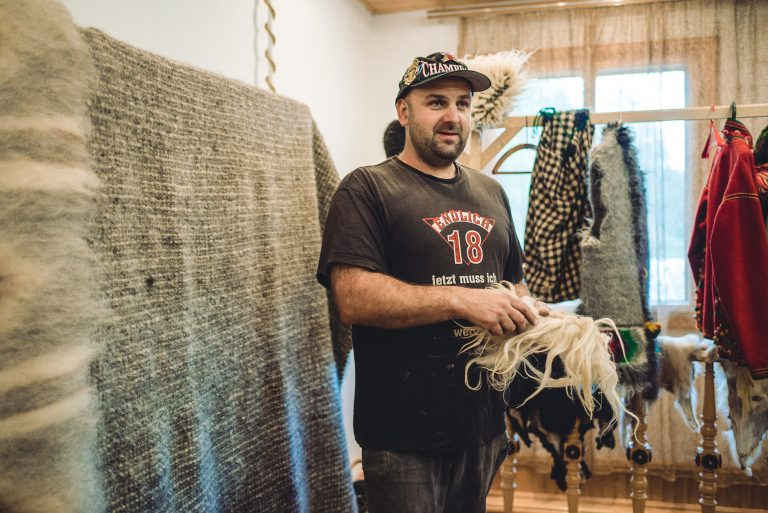
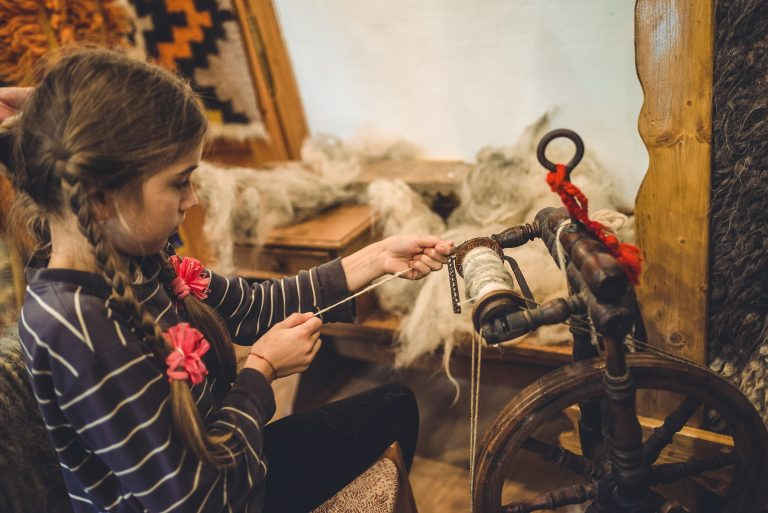
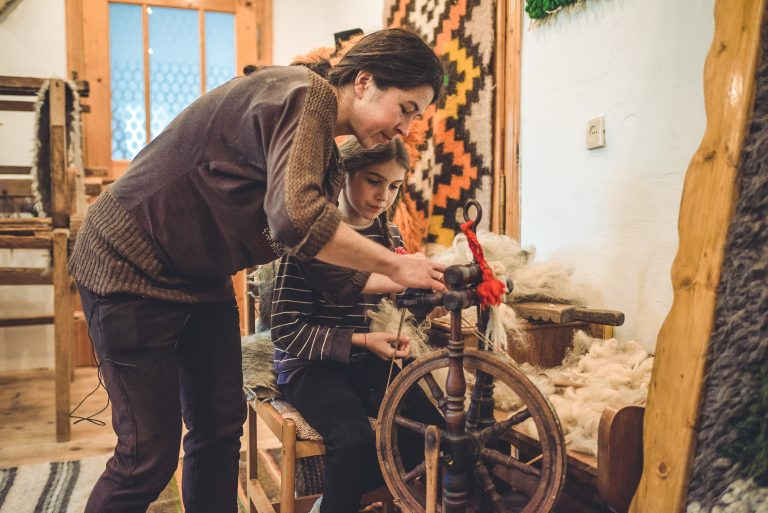
slideshow
Yaroslav, Natalia’s husband, can weave too. He made his first lizhnyk in the eight grade. So it’s no surprise their children are in the family business too. Slavko was already very skilled in spinning a base thread at the age of thirteen and Julia made her first money from small cloaks.
As Julia learns to weave, she is trained to feel the rhythm of the spinning wheel. When spinning, it is important to have the thread administered and the wheel spinning in the same tempo. If done this way, the thread will be tight and it will not tear. Yaroslav compares spinning a thread with playing an accordion: first, you learn to play bass, and then both keyboards at the same time.
— Singing is a vital part of weaving. This way you supply your work with positive energy. This is what makes our products different from those made in a factory.
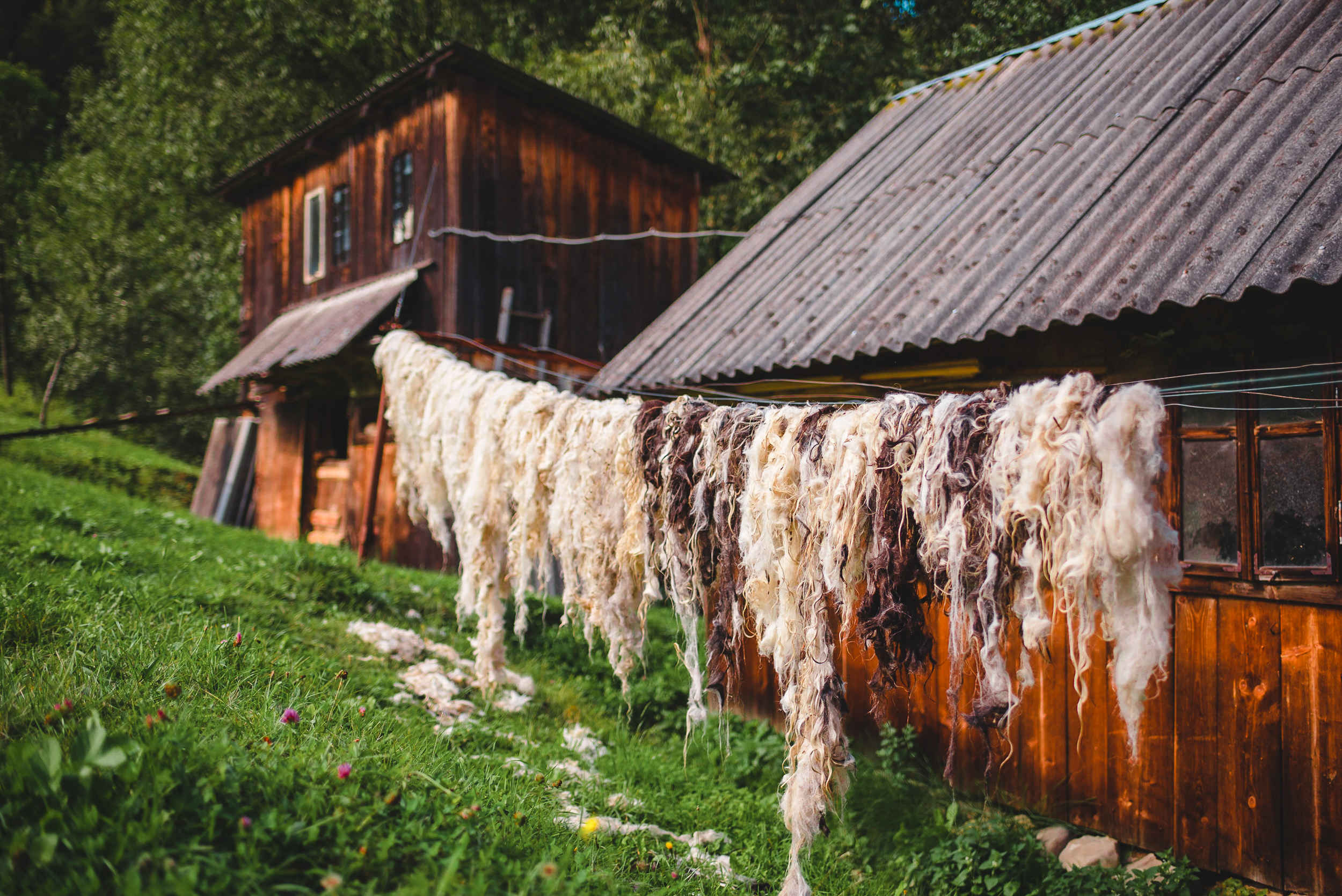
Lizhnyk manufacturing
The process of making woolen blankets consists of several stages. Everything starts with the preparation of the wool. It must be washed, dried, rolled, and only then the thread is made.
— If I were the only one to make a lizhnyk, it would take me six days, but we do it this way: we wash a lot of wool at the same time, then dry it. We spin the thread in advance in the evenings or mornings and this way we are able to do more and earn money, because this is the only way for us to continue.
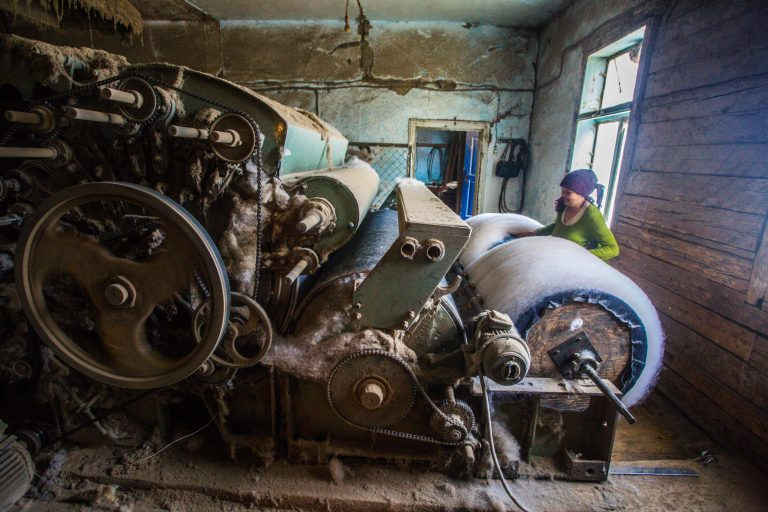
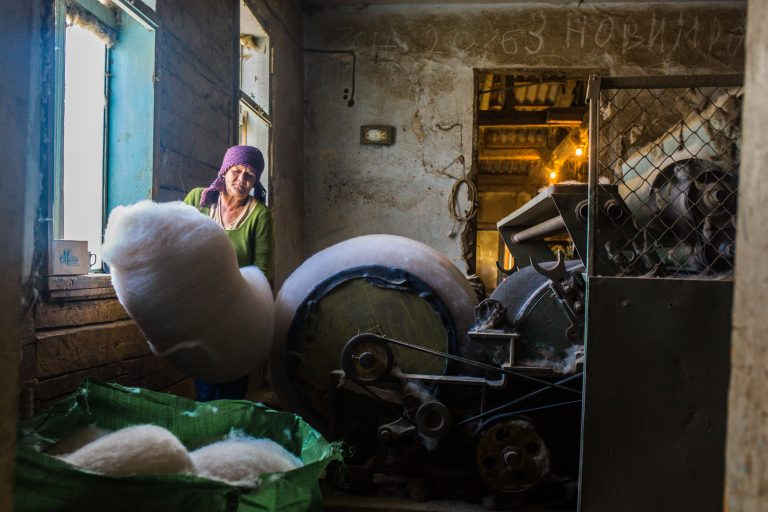
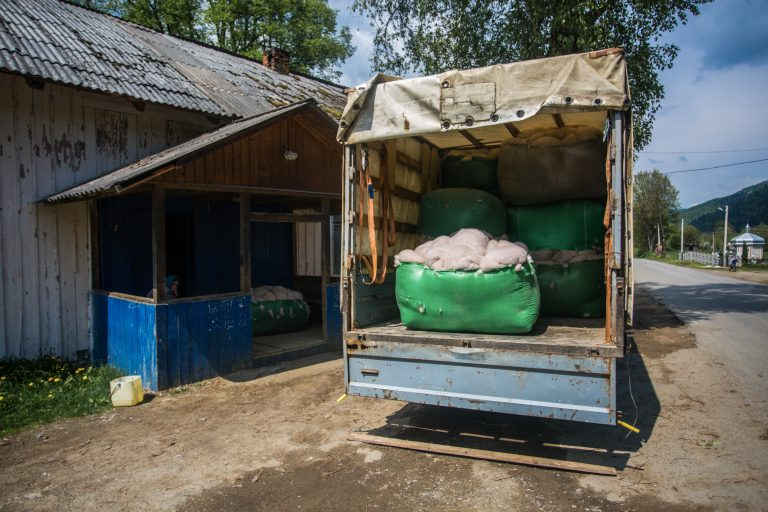
slideshow
Hanna shows us the correct way to spin. She says that you can learn it in one day. With one hand, you must collect the fiber of the wool and let it go thinner and thicker onto the spindle, which spins from the little finger to the thumb. In the hands of Hanna, the spindle rotates so fast that we can barely keep track of how the wool bag turns into even thick threads. Yarn that’s already been wrapped is called “motashka”, because it is reeled up on a special device, a “motovylo”. Motashka, if necessary, can be submerged into boiling water, soaked, and painted in different colors.
Hanna makes the warp out of thin woolen thread, made by a local eighty-six-year-old grandma. This is the point where the magic starts, the moment a craftswoman creates a lizhnyk.
— The warp, which is also woolen, is wrapped around the “volotylo”, — she says. — Each thread has its own slot and these threads are assembled in a certain order: first, second, first, second, first, second — in this way from one end to another. These threads are attached to leg levers. You really need to use legs to regulate the warp — press one and the warp goes up, press another and it goes down. There is a big lot where we put the motashka, the rough thread. I arranged it, dragged it though the warp. I now let one leg lever loose; part of the warp rises and the threads cross. Then I batter it hard enough to hear a loud knock. You need to batter it really hard to make a lizhnyk firm, and the most important part of it is the warp. The more solid the warp is, the more lasting the blanket will be.
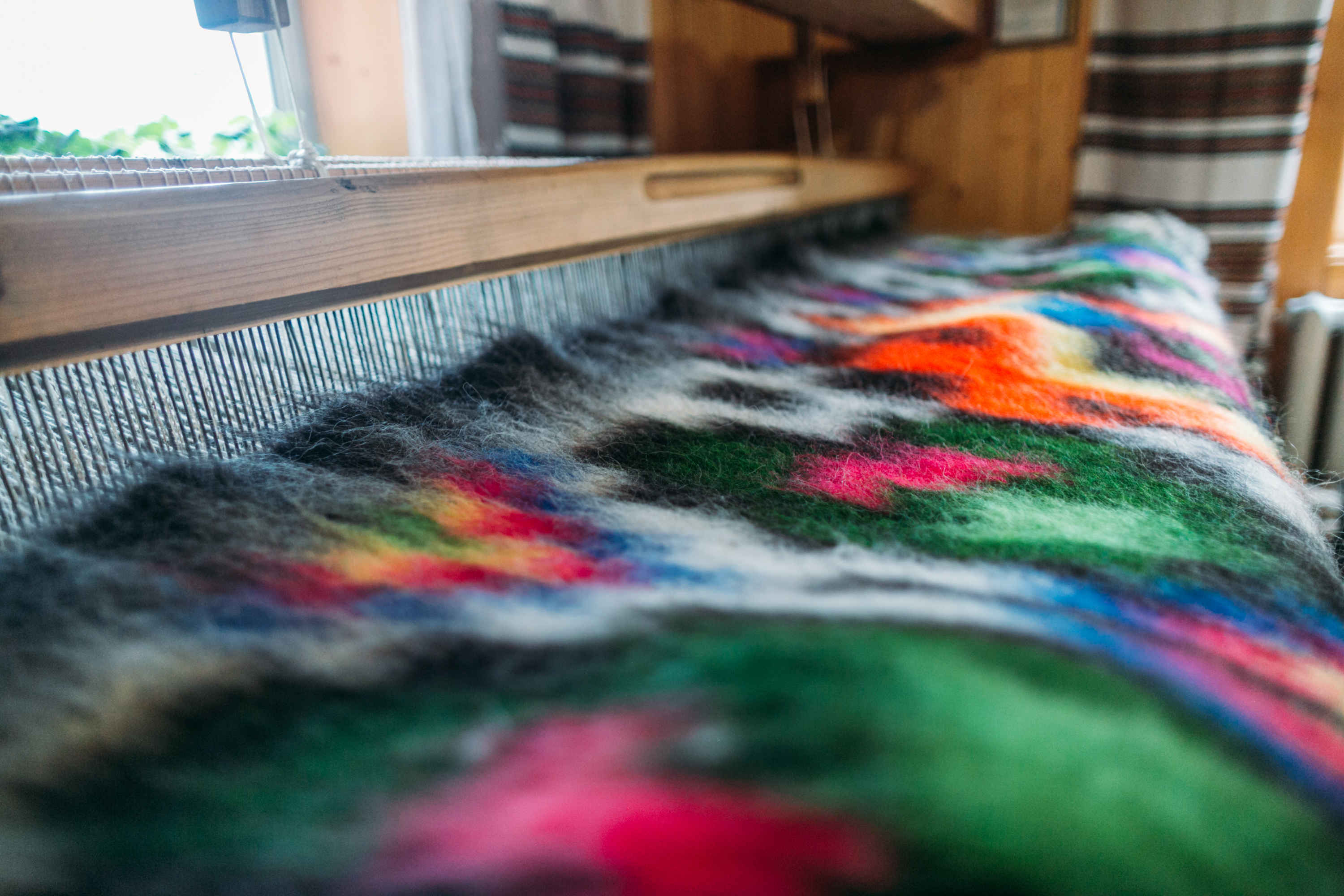
Hanna loves to paint palettes, to weave without a plan and letting colorful patterns come out. To get the picture, you need to count the number of threads of the base, which the rough thread goes through.
— I must foresee every detail of that blanket. I must keep everything in mind so that every bit stays where it belongs. When you have enough skill, it takes a day by the loom to make a lizhnyk. Hanna says it doesn’t take much time to become skilled. Young girls often master this craft, as there is not much other work here.
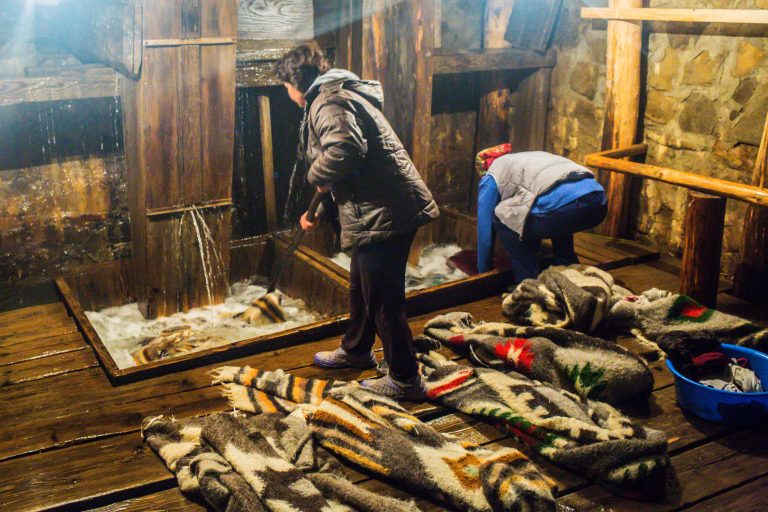
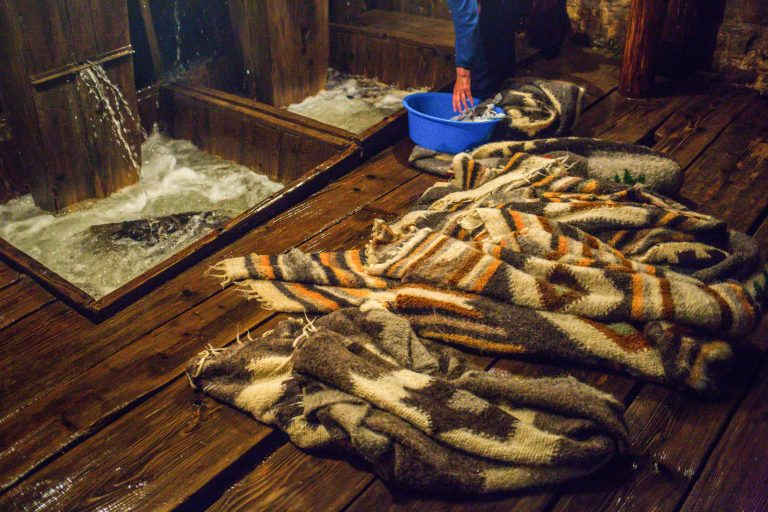
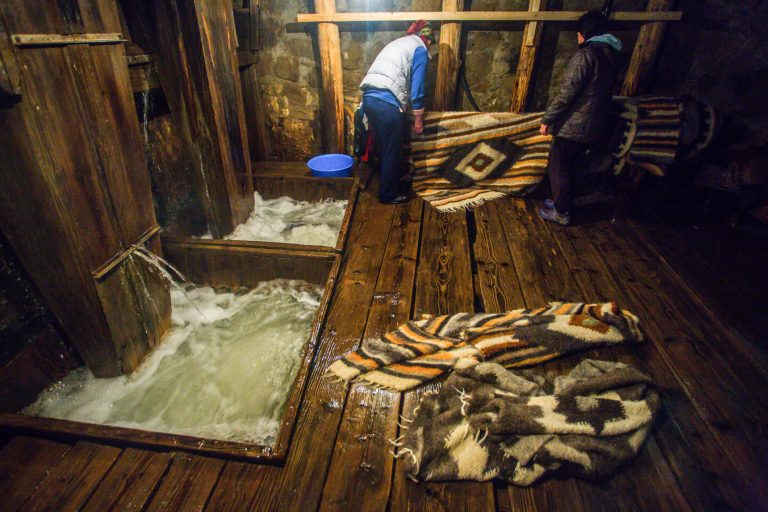
slideshow
A lizhnyk, fresh from the loom, is called “bald”. It can’t be used right away, because the warp is flimsy and threads can pop out. To make it robust, tough and long-lasting, it must go through a “valylo” — a water tumble, where it spends three to eight hours. The great force of the stream tightens the threads and shrinks the blanket up to 40 centimeters. This way it becomes thicker, tougher and a little fluffy on the surface.
The next step is combing the lizhnyk out. It is hard and monotonous process. You need to spend several hours working with a special large brush. If needed, you can comb it out from one side or both. This procedure makes a blanket fluffy and soft to touch.

Plein Air
For the last fifteen years, Yavoriv has been host to a creative plein air laboratory, organized by the Department of Fine Textiles of the Lviv Academy of Arts. The topic is different every year. A plein air event consists of three parts: a scientific conference, a practical stage and an exhibition of works made during the second stage. Each stage takes place at different locations.
The main purpose of the plein air is to introduce participants to traditional art, to show that folk art can be modern and fashionable. The artists share their creative vision and accomplishments, mix techniques and materials, thereby opening up something new.
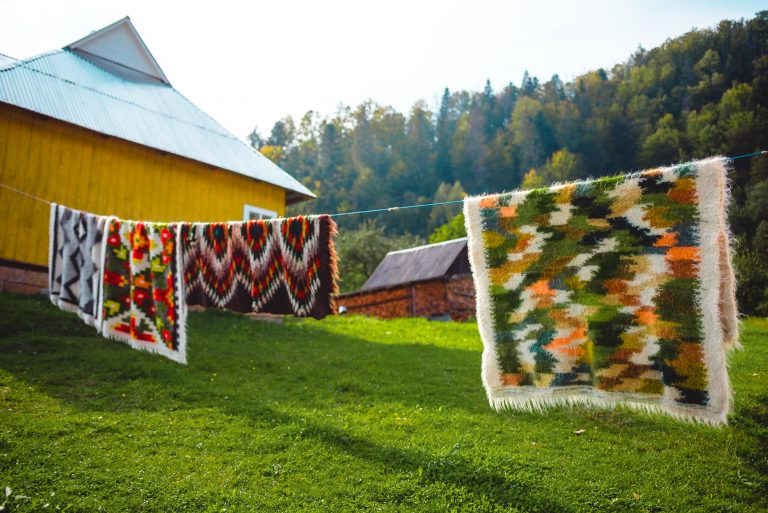
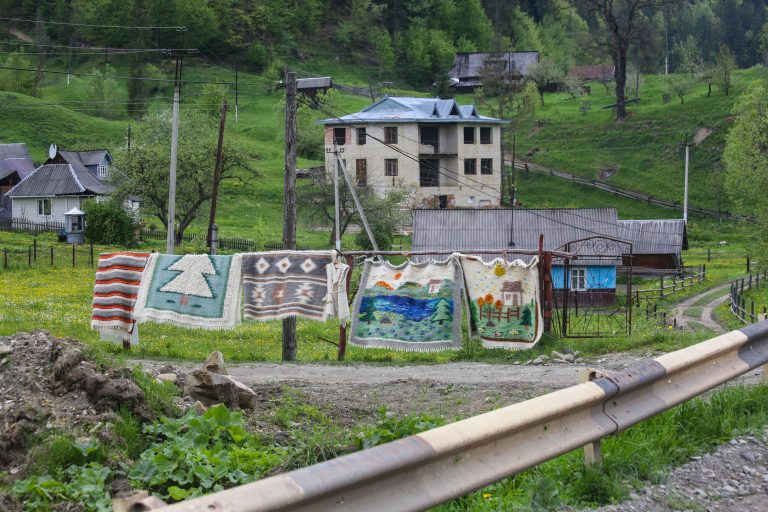
slideshow
However, they tend to pay more attention to the new kinds of art, and there are always those who want to get acquainted with the traditional craft of making woolen blankets.
Hanna Kopylchuk is a co-organizer of a part of the plain air that takes place in Yavoriv. She takes participants to her workshop, holds master classes, and shares her experience and knowledge. In 2007, her works were displayed at the Palace of Arts. Volunteers had a chance to weave, painted patterns for blankets and simply learned about Hutsul culture.
— For some people, it was easy to weave, for some it was not. Some painted very complex patterns. We tried to weave some of them.
The art of making lizhnyks attracts not only people from Ukraine, but visitors from other countries also come to the plein airs too. There were guests from Switzerland, Austria, and Germany. A participant once arrived from India. He spoke neither Ukrainian nor English, so he hired an interpreter to be able to chance to participate.

Tourists
Tourists are attracted by the beautiful nature and impressive monuments of Yavoriv, and they often buy the woolen blankets as souvenirs. Narrow carpets for wall hangings or to lay on the floor are also popular among tourists. People call them “khidnyk”, and like the blankets, they are also woolen and made on a loom. Locals don’t often order khidnyks, so they are mostly sold as souvenirs for foreigners.
Foreigners often come to Yavoriv for tours.
— We had tourists from China and they said, “Don’t tell and don’t show it to the Chinese, or they will do it too. They now do everything.” And the Chinese said, “Your sack of wool is bigger than us. We won’t do it.”
Backstage
Watch how the Ukraїner team visited Yavoriv, as new members join our team every day. Check out how people welcomed us and what we ate.
Attention to all the people with a limited sense of humour: this vlog includes the jokes and sarcasm about the Yakubovich Museum and his rider!

